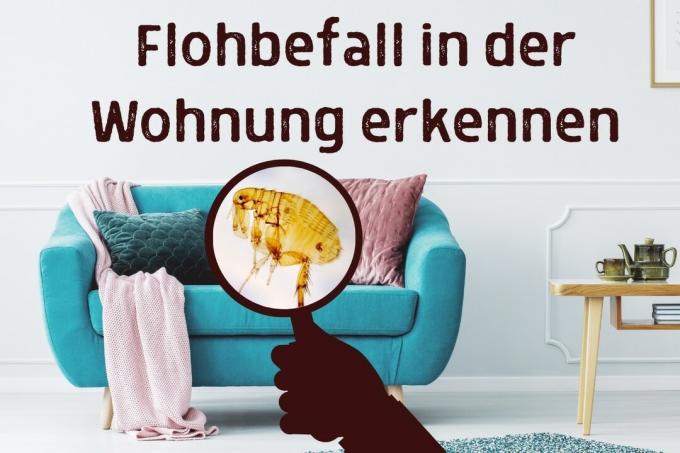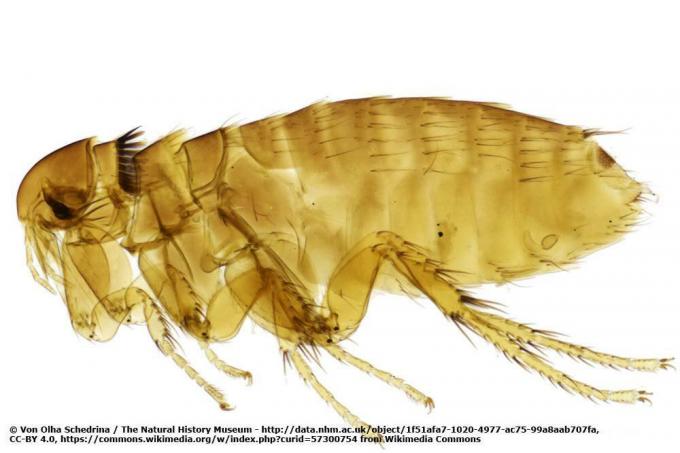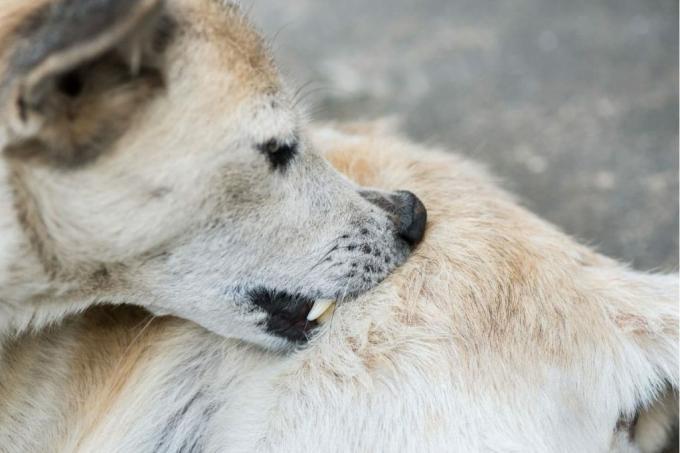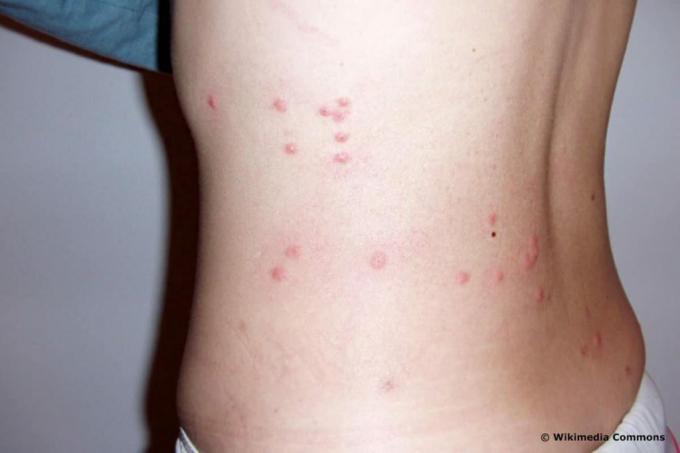
table of contents
- Order and Cleanliness
- Features of a flea
- Flea eggs are plump
- Flea larvae are free-living
- Itching and flea bites
- Note traces of manure
- frequently asked Questions
Fleas not only infect dogs, cats and the like, they also do not stop at humans. Various signs can indicate the presence of fleas in the apartment. More on this below.
In a nutshell
- a flea is visible to the naked eye
- 2 to 3 mm in size
- the parasites can sting
- Stings and traces of excrement are signs of a flea infestation
Order and Cleanliness
Order and cleanliness in the apartment is not always a guarantee that fleas will not settle there. Of course, it contributes significantly to a "flea-free home". Fleas prefer to choose dogs, cats and other mammals as their "food source". Here they can suck blood as they please. However, people are not always spared from these pests. You will then even find your way into the house and apartment. They usually get there with dog and cat. They can also be a souvenir from walks in the woods and fields. They can also accompany people into the house after they have finished gardening. The following signs must then be observed in order to be able to determine a flea infestation.
Features of a flea
Fleas can be seen with the naked eye in the home with a bit of difficulty. It is typical of these pests that they can make long leaps. The appearance of the adult animals is characteristic:

- 2 to 3 mm in size
- rounded body shape
- Body flattened laterally
- encased in hard chitin armor
- brown to reddish in color
- six long legs with claws
- strong hind legs
- Body and legs covered with bristles
- strong mouthparts
- Combination of a suction and a proboscis
- no wings
With the help of the strong hind legs, these parasites can make long leaps of up to a meter to reach their victims. However, not only is the detection of a flea important in order to determine an infestation and then take appropriate control measures. Finding and recognizing flea eggs and flea larvae is more important here.
Note: Fleas are not generally tied to a single host. Dog and cat fleas can also infect humans, although dogs and cats are the most favorable conditions for egg production and storage.
Flea eggs are plump
Females lay up to 50 eggs per day, preferably in the fur of domestic animals. From there they just fall off the animal. Usually they can then be found in carpets, upholstered furniture or blankets. These are not really visible to the naked eye. A magnifying glass should therefore be used to help. They are:
- plump
- smooth and non-sticky
- pearly white
- 0.3 to 0.5 mm in size
There is a simple method to detect flea eggs on carpets and upholstered furniture:
- Put on slightly darker rubber gloves
- Run your hand over carpets or upholstered furniture
- white "dots" confirm flea infestation
- Use magnifying glass
After egg-laying, the flea larvae usually hatch within two to five days, depending on the prevailing temperature and humidity.

Flea larvae are free-living
Flea larvae are usually found in the floor area of the home. You like to stay Carpetswhere they dig themselves deep. Popular places to stay are also behind baseboards and in other cracks and crevices. They feed mainly on organic matter such as flakes of skin, crumbs and the droppings of adult fleas in the home. This consists of undigested blood. Features of flea larvae are:
- 2 to 5 mm in size
- whitish colored
- Body provided with bristles
- hence the name "wireworms"
Until the larvae are fully developed, they molt twice. Then they pupate. The larvae spin into a silky cocoon. Under favorable conditions, adult fleas develop from this in the apartment within three to five weeks. However, it can sometimes take much longer, up to six months or a year, for development to complete if there are no hosts for the flea in sight. Therefore, a flea infestation in the house is sometimes recognized quite late. However, if a suitable host approaches, it will be recognized by its body heat, vibration by footsteps and the emitted carbon dioxide in the breath. After hatching, the flea needs its first blood meal.
Note: Only five percent of animals in a population are present on hosts. The remaining 95 percent consists of eggs, flea larvae and pupae, which can be found near the host.
Itching and flea bites
Another sign of a flea infestation can be severe, persistent itching and flea bites. Not only dogs and cats have to scratch each other incessantly after a flea bite and tend to perform atypical movements, humans are not immune from flea bites either. The itching arises after every bite. The bite itself is barely noticed because the saliva of a flea contains some kind of blood coagulant and pain reliever. Flea bites are relatively difficult to spot on pets. With the help of a flea comb, the fur can be combed to the side to find the parasites, their droppings and stings. The neck, head and hind paws are preferably affected. With humans it is a little easier:
- Appearance of redness and wheals
- colored bright red
- a stitch only a few millimeters in size
- arranged in a row
- hence the name Flohstrasse comes from

Note traces of manure
Another indication of the presence of fleas in the apartment is finding traces of feces. However, this is not always very easy, as they are difficult to see with the naked eye. Feces are excreted, undigested blood that has been sucked from a host. The droppings are tiny, resembling a small black crumb. There are various ways to detect traces of manure:
- use a sheet of white paper or kitchen paper
- either pet comb on it or
- Collect droppings
- Slightly moisten the cloth
- Grind the crumbs
- black color remains, simple crumbs of dirt
- red-brown discoloration, flea droppings
- Discoloration from existing blood
Alternatively, flea droppings on carpets and upholstered furniture can be detected as follows:
- put on white stockings
- walk across the carpet
- black dots indicating faeces
- Upholstered furniture can also be examined in this way
- Wipe furniture with a white sock or white cloth
Note: Fleas are mainly active in the months of July to October. However, they can operate all year round in heated apartments.
frequently asked Questions
A serious threat as in the 14th The century, when the plague was transmitted by rat fleas, no longer exists today. However, flea bites can cause allergies in humans, cats and dogs. Furthermore, tapeworms can be transmitted through flea bites, which are also dangerous for humans.
If pets are present, they must be treated as quickly as possible with flea products such as spot-on preparations. It is also important to get rid of all flea eggs and larvae. To do this, carpets, mattresses, upholstered furniture, etc. be treated with a vacuum cleaner or steam cleaner. Textiles and other washable materials are washed at at least 60 ° C in the washing machine.
Yes of course. Pets should be constantly checked for fleas. Their fur should be brushed and combed regularly. The use of spot-on preparations is advisable for prevention. In addition, it is necessary to thoroughly clean the entire living space on a regular basis. The best way to do this is to use a vacuum cleaner. It is also important to wash your hands after gardening and to check for flea infestations, because fleas lurk here too.



